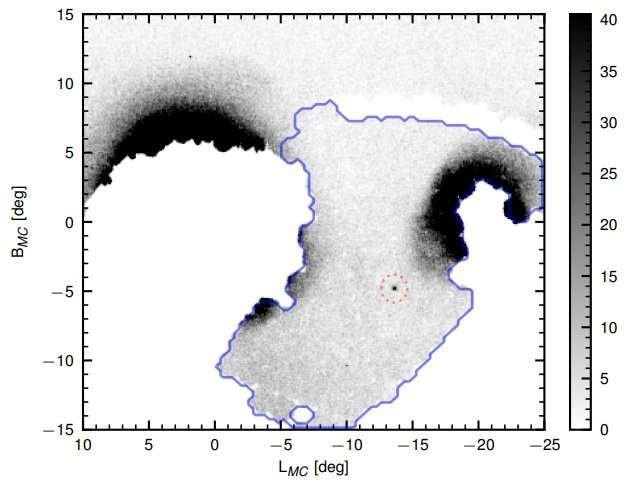The density of main sequence turn-off in the Magellanic Clouds region. The location of newly discovered dwarf galaxy in between Large Magellanic Cloud (on the left) and Small Magellanic Cloud (on the right) is marked by a red dashed circle. Credit: Koposov et al. 2018.
An international group of astronomers reports the detection of a new dwarf galaxy in the so-called Magellanic Bridge – a stream of gas linking the two Magellanic Clouds. The newly found galaxy, designated Hydrus 1, is described in a paper published April 17 on the arXiv pre-print server.
The new galaxy was found in the Hydrus constellation. It is a small a small constellation in the deep southern sky. Its name means a "male water snake." Therefore, the astronomers refer to the newly discovered galaxy as a "snake in the clouds."
Hydra 1 was discovered by a team of researchers led by Sergey E. Koposov of the Carnegie Mellon University. They used the Dark Energy Camera (DECam) mounted on the 4-m Blanco Telescope located at Cerro-Tololo Inter-American Observatory (CTIO) in Chile to observe the region between the Small (SMC) and the Large Magellanic Cloud (LMC).
Analysis of spectroscopic data obtained by DECam resulted in the identification of a new ultra-faint dwarf galaxy.
"In this paper we presented the discovery and detailed analysis of a new ultra-faint Milky Way satellite, called Hydrus 1," the researchers wrote in the paper.
The study reveals that Hydrus 1 is a mildly elliptical and ultra-faint system, located some 90,000 light years away from the sun and around 78,000 light years away from the LMC. The galaxy has an absolute magnitude of –4.7 a circularized half-light radius of approximately 163 light years, and a surface brightness noticeably brighter than many typical ultra-faint dwarf spheroidals.
According to the astronomers, these parameters indicate that Hydrus 1 is most likely a dwarf galaxy; however, it may also be an extended globular cluster.
The observations found that Hydrus 1 has an old, metal-poor stellar population with several blue horizontal-branch stars and two RR Lyrae variables. The researchers also noted that the system is dark matter dominated, what once more suggests that it may be a globular cluster with a small amount dark matter or a dwarf galaxy that lost some dark matter due to tides.
When it comes to chemical composition, the study found that Hydrus 1 is rather metal poor, with mean metallicity of –2.5. What is noteworthy, the system has one carbon-enhanced extremely metal-poor star with metallicity of about –3.0 and a carbon to iron abundance ration of around 3.0.
"This level of carbon enrichment makes it one the most carbon-enhanced stars known in both the Milky Way halo and the dwarf galaxies," the paper reads.
The researchers concluded that Hydrus 1 is most probably a part of the Magellanic family of satellites that were brought into our home galaxy by the Magellanic Clouds. This assumption is based on the spatial position and the observed line-of-sight velocity of the system. However, more observations are still needed to definitely confirm this hypothesis. Therefore, the authors of the paper hope that the upcoming Gaia Data Release 2 (DR2), containing data obtained by ESA's Gaia satellite, will be helpful in uncovering more details about the disputed connection between Hydrus 1 and the LMC.
More information: Snake in the Clouds: A new nearby dwarf galaxy in the Magellanic bridge, arXiv:1804.06430 [astro-ph.GA] arxiv.org/abs/1804.06430
Abstract
We report the discovery of a nearby dwarf galaxy in the constellation of Hydrus, between the Large and the Small Magellanic Clouds. Hydrus 1 is a mildy elliptical ultra-faint system with luminosity MV∼ -4.7 and size ∼ 50 pc, located 28 kpc from the Sun and 24 kpc from the LMC. From spectroscopy of ∼ 30 member stars, we measure a velocity dispersion of 2.7 km/s and find tentative evidence for a radial velocity gradient consistent with 3 km/s rotation. Hydrus 1's velocity dispersion indicates that the system is dark matter dominated, but its dynamical mass-to-light ratio M/L ∼ 66 is significantly smaller than typical for ultra-faint dwarfs at similar luminosity. The kinematics and spatial position of Hydrus~1 make it a very plausible member of the family of satellites brought into the Milky Way by the Magellanic Clouds. While Hydrus 1's proximity and well-measured kinematics make it a promising target for dark matter annihilation searches, we find no evidence for significant gamma-ray emission from Hydrus 1. The new dwarf is a metal-poor galaxy with a mean metallicity [Fe/H]=-2.5 and [Fe/H] spread of 0.4 dex, similar to other systems of similar luminosity. Alpha-abundances of Hyi 1 members indicate that star-formation was extended, lasting between 0.1 and 1 Gyr, with self-enrichment dominated by SN Ia. The dwarf also hosts a highly carbon-enhanced extremely metal-poor star with [Fe/H] ∼ -3.2 and [C/Fe] ∼ +3.0.
© 2018 Phys.org
























